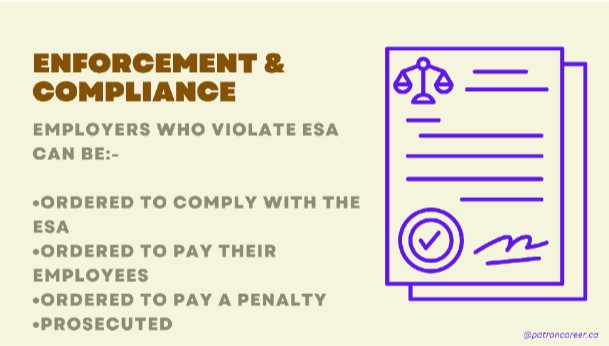
Workplace Violence Prevention
11 January, 2023
Patron Career Staffing firmly believes in adopting a tailored approach to meet temporary and permanent recruitment needs. We safeguard the interest of our clients by finding such workers who are knowledgeable and reliable.
About UsNeed help? Make a Call
32 Dundas Street East Unit A, L5A1W2

Staying compliant with local laws is every employer's core responsibility. But it is not child’s play and not something companies and business owners can sneeze at. Canada has ample legislation aimed at safeguarding employees' rights in the workplace. Such workplace-related laws explicate employers on what they can or cannot make you do.
One such law is the Employment Standards Act (ESA) which protects most workers in Ontario and lays down employment criteria about hours you work, minimum wages, vacation, public holidays, and more.
Our simple guide spells out provisions that regulate employment in Ontario, its applicability along with some exceptions. As an employer, you must abide by various modalities that are put in place to ensure that workers' rights are protected at all costs. out there.
Sit tight as we bring this truckload of information to your benefit.
The Employment Standards Act, of 2000 is provincial legislation in Ontario that contains minimum requirements or what we call ‘employment standards’ for how business operators manage workers and what these workers can expect from their employers. The act majorly boils down to distinct aspects of employment, such as how employers can treat their workers fairly and reduce discrimination to its minimum.

The Ontario Employment Standards Act prescribes an array of important subjects guaranteed to most workers in the province. But there are a few occupational exceptions to this. Let us explore the minimum standards of employment rights: department are:
1. Minimum wages
The employer must provide all employees with their wage statement which is meant to describe:
So that the employees are not underpaid. Such a statement can be in writing or sent by e-mail to the employees. The act stipulates minimum wages per hour to casual workers, full-time, part-time, or employees paid at an hourly rate, piece rate, salary, etc. Minimum wage can vary for students, liquor servers, homeworkers, and hunting, fishing, and wilderness guides.
2. Overtime pay
As per the act, if a worker exceeds the weekly limit on the maximum number of work hours, i.e. 48 hours, he is eligible for overtime work. This rate should be at least 1 1/2 times the regular wage rate (also called "time and a half”). Even salaried employees can get overtime pay. But managers and supervisors are not entitled to it. Not that overtime of a worker is calculated fairly- weekly, or on basis of an averaging agreement. For more information, click here!
3. Public holidays

Ontario has nine public holidays each year. Employees are allowed to take all these days off and be paid statutory holiday pay. The act also states various rules regarding pay rates, premium pay, substitute holiday, the “last and first-day rule” and more.
4. Vacation time and pay
Most employees with less than five years of employment are qualified for at least two weeks of vacation after every year, however, some employees are exempted from it. Vacation pay is made to full and part-time employees at four percent of the gross wages earned in the 12- month entitlement year or stub period.
Many provinces provide three weeks of vacation time to employees with five or more years of employment. Such employees are paid at least six percent of the total wages earned by them.
5. Pregnancy and parental leaves
Pregnant employees can avail pregnancy leave of up to 17 weeks off work. Such leave is unpaid but job-protected. The persons entitled to pregnancy leave are:
New parents can take parental leaves of up to 63 weeks and birth mothers who avail pregnancy leave can take up to 61 weeks off work owing to parental leave. The essential qualification remains the same as enunciated above.
6. Severance pay
Severance pay is a form of compensation made by the employer to a long-term employee for their separation from the business entity. It should not be confused with termination pay. The act states when severance occurs, exempted persons, and also the qualifications and amount of severance pay. Be advised that the maximum amount of severance pay is 26 weeks.
Who is not covered under the Employment Standards Act?
The ESA of Ontario does not cover the following occupations, industries, and jobs:
Access the complete list of special exceptions for various other categories, here.
This is not a legal document. For detailed information, kindly check the ESA.
